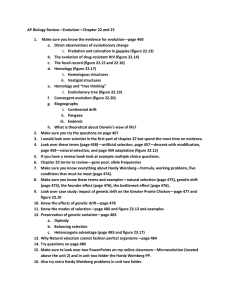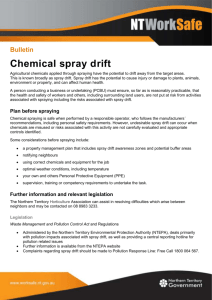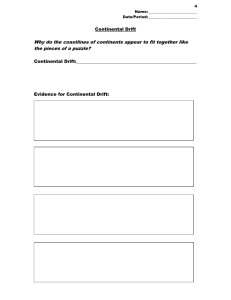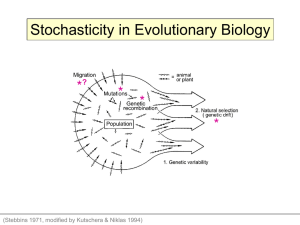C E Pesticide Drift OOPERATIVE
advertisement
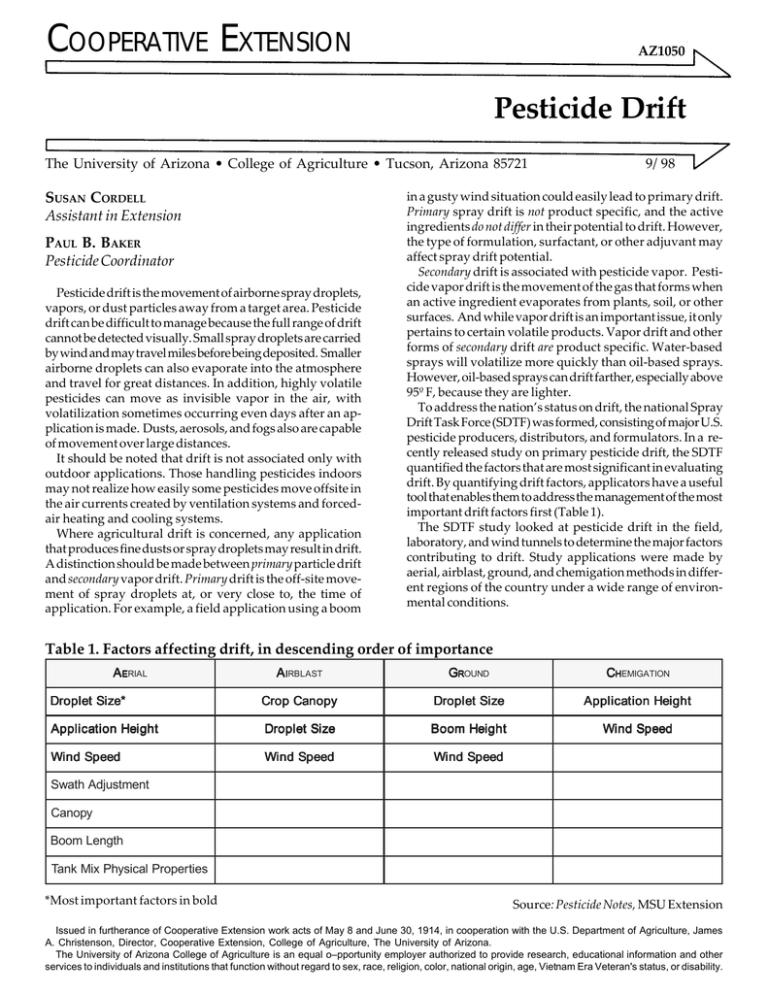
COOPERATIVE EXTENSION AZ1050 Pesticide Drift The University of Arizona • College of Agriculture • Tucson, Arizona 85721 SUSAN CORDELL Assistant in Extension PAUL B. BAKER Pesticide Coordinator Pesticide drift is the movement of airborne spray droplets, vapors, or dust particles away from a target area. Pesticide drift can be difficult to manage because the full range of drift cannot be detected visually. Small spray droplets are carried by wind and may travel miles before being deposited. Smaller airborne droplets can also evaporate into the atmosphere and travel for great distances. In addition, highly volatile pesticides can move as invisible vapor in the air, with volatilization sometimes occurring even days after an application is made. Dusts, aerosols, and fogs also are capable of movement over large distances. It should be noted that drift is not associated only with outdoor applications. Those handling pesticides indoors may not realize how easily some pesticides move offsite in the air currents created by ventilation systems and forcedair heating and cooling systems. Where agricultural drift is concerned, any application that produces fine dusts or spray droplets may result in drift. A distinction should be made between primary particle drift and secondary vapor drift. Primary drift is the off-site movement of spray droplets at, or very close to, the time of application. For example, a field application using a boom 9/98 in a gusty wind situation could easily lead to primary drift. Primary spray drift is not product specific, and the active ingredients do not differ in their potential to drift. However, the type of formulation, surfactant, or other adjuvant may affect spray drift potential. Secondary drift is associated with pesticide vapor. Pesticide vapor drift is the movement of the gas that forms when an active ingredient evaporates from plants, soil, or other surfaces. And while vapor drift is an important issue, it only pertains to certain volatile products. Vapor drift and other forms of secondary drift are product specific. Water-based sprays will volatilize more quickly than oil-based sprays. However, oil-based sprays can drift farther, especially above 95º F, because they are lighter. To address the nation’s status on drift, the national Spray Drift Task Force (SDTF) was formed, consisting of major U.S. pesticide producers, distributors, and formulators. In a recently released study on primary pesticide drift, the SDTF quantified the factors that are most significant in evaluating drift. By quantifying drift factors, applicators have a useful tool that enables them to address the management of the most important drift factors first (Table 1). The SDTF study looked at pesticide drift in the field, laboratory, and wind tunnels to determine the major factors contributing to drift. Study applications were made by aerial, airblast, ground, and chemigation methods in different regions of the country under a wide range of environmental conditions. Table 1. Factors affecting drift, in descending order of importance A ERIAL A IRBLAST GROUND CHEMIGATION Dro p l et Si ze* Cro p Can o py Dro p l et Si ze A p p l i c at i o n Hei g h t A p p l i c at i o n Hei g h t Dro p l et Si ze B o o m Hei g h t Wi n d Sp eed Wi n d Sp eed Wi n d Sp eed Wi n d Sp eed Swath Adjustment Canopy Boom Length Tank Mix Physical Properties *Most important factors in bold Source: Pesticide Notes, MSU Extension Issued in furtherance of Cooperative Extension work acts of May 8 and June 30, 1914, in cooperation with the U.S. Department of Agriculture, James A. Christenson, Director, Cooperative Extension, College of Agriculture, The University of Arizona. The University of Arizona College of Agriculture is an equal o–pportunity employer authorized to provide research, educational information and other services to individuals and institutions that function without regard to sex, race, 1 religion, color, national origin, age, Vietnam Era Veteran's status, or disability. The study found that the risk of primary pesticide drift is a result of factors such as the equipment set-up, application height, and wind. (There are also small “carrier” effects due to the nature of the solvents present in the formulation.) Potential for primary pesticide drift depends on the following: • droplet size • wind speed and direction • air movement/temperature gradient • application height • nozzle type • pressure • temperature • humidity • physical properties of the product • terrain/crop canopy The SDTF also looked at buffer zones. Buffer zones are set distances around schools, day care centers, health care facilities, and residential areas where applicators must observe certain restrictions. Areas of concern are protected by buffer zones, established to prevent the movement of pesticides from application sites. Areas of concern are sites or living things that can be easily injured by a pesticide. Outdoor sites include areas: Sites of concern indoors include areas: • where people — especially children, pregnant women, the elderly, or the sick — live, work, or are cared for • where food or feed is processed, prepared, stored, or served • where domesticated or confined animals live, eat, or are otherwise cared for • where ornamental or other sensitive plantings are grown or maintained In the SDTF study of buffer zones, no drift was measured upwind from application sites. Therefore, waiting until the wind is blowing away from an area of concern can be more effective in protecting that area than using a downwind buffer zone. The study also found that there is always some level of drift measured downwind from the treatment site, suggesting that there may always be some level of drift with current application methods. Arizona requires that agricultural applicators observe buffer zone restrictions (Table 2) when making applications of either highly toxic or odoriferous pesticides near schools, day care centers, health facilities, or residential areas. State criminal and civil violations can result in fines and other penalties. Federal violations can result in a $25,000 fine and one year in prison for commercial applicators, and $1000 and 30 days for private applicators. License suspension and loss of certification may also occur. • where ground water is near the surface or easily reached (wells, sinkholes, porous soil, etc.) • in or near surface water • near schools, playgrounds, hospitals, and other institutions Steps applicators can take to reduce pesticide drift (Table 3) are: • near the habitats of endangered species • • near apiaries (honeybee sites), wildlife refuges, or parks • near ornamental gardens, food or feed crops, or other sensitive plantings Apply pesticides in the evening or early in the morning. These are the best times to avoid wind problems. (Evening is best, early morning is next, and both are better than daytime application.) Table 2. Buffer zones for pesticide applications in Arizona. SCHOOL/D /DAY CA RE HEALTH CA RE RESIDENTIAL Highly toxic (liquid) 1/4 mile 400 ft. 100 ft. Highly toxic (dust) 1/4 mile 400 ft. 300 ft. Odiferous 1/4 mile 1/4 mile 1/4 mile Highly toxic (liquid) 1/4 mile 400 ft. 50 ft. Highly toxic (dust) 1/4 mile 400 ft. 300 ft. Odiferous 1/4 mile 1/4 mile 1/4 mile A er i al A p p l i c at i o n Gro u n d A p p l i c at i o n 2 Table 3. Summary of Recommended Procedures for Reducing Drift Damage (Ground Application) Pro c ed u r e Ex am p l e Ex p l an at i o n Use the largest droplets possible while providing necessary coverage. Select a nozzle type that produces coarse droplets. Use wide-angle full cone, or flooding nozzles. Use the lower end of the nozzle's pressure range. Use 20 to 40 psi for Raindrop and less than 25 psi for other nozzle types. Higher pressures generate many more small droplets (less than 100 microns). Lower boom height. Use the lowest boom height possible while maintaining uniform distribution. Wind speed increases with height.Lowering boom height by a few inches can reduce off-target drift. Increase nozzle size. If normal gallonage is 15 to 20 gpa, increase to 25 to 30 gpa. Larger capacity nozzles will reduce spray deposited off-target. Spray when wind speeds are less than 10 mph and when wind direction is away from sensitive plants. Leave a buffer zone if sensitive plants are downwindSpray buffer zone when the wind changes. More of the spray volume will move off-target as wind increases. Do not spray when the air is completely calm. Absolutely calm air generally occurs in early morning or late evening Absolutely calm air reduces mixing, and leaves a spray cloud that may move downwind at a later time Use a drift control additive when needed Several long-chain polymer products are available. Drift control additives increase the average droplet size produced by nozzles. Source: Loren E. Bode and R.E.Wolf, Agricultural Engineering Dept., Univ. of Illinois. • Do not apply if the wind exceeds a range of five to seven miles per hour, even if the legal limit is greater. • Determine wind direction and consider this when determining application timing, equipment, and whether or not to make an application. The wrong wind direction can cancel everything done to reduce drift! • Do not spray during thermal inversions, when air closest to the ground is colder than the air above it. When possible, avoid spraying at temperatures above9095º F, ideally not over 85º F. • Use the largest nozzle opening that gives adequate coverage. • Use solid cone or fan spray nozzles that produce larger droplets. • Use the lowest pressure possible consistent with good coverage and nozzle design. • Add drift control agents to produce larger droplets and reduce the possibility of drift, especially when working near areas of concern such as a water source. Read the label for specific instructions. • Choose a formulation less subject to drift: dusts are the most likely to drift, sprays are intermediate, and granules are the least likely to drift. 3 • Choose the best application method for the circumstances. For example, ground equipment usually causes less drift than aerial application, but an airblast sprayer used on the ground may be highly susceptible to drift, depending on the nature of the crop canopy. • For applications of liquid and dry formulations, commercially available or homemade shrouds or skirts attached over or behind the application equipment can help prevent spray droplets and pesticide particles from becoming airborne. • Know your surroundings. Pesticide drift in the air cannot be stopped. The polluted air creates a hazard for people, animals, and plants that contact it. Pesticides in the air may contaminate soil, air, and water. They may settle onto water, crops, livestock, trees, parks, or houses. Drift has the potential to contaminate, damage, or kill agricultural, ornamental, turf, and forestry crops planted on contaminated soil. Contaminated soil may cause problems with grazing and crop rotations, and with recreational and residential sites. (Sources: Arizona Agricultural Pesticide Applicator Training Manual, Univ. of Arizona, 1997; Pesticide Notes, Michigan State Univ., 1996; Information Sheet, Delaware Dept. of Agriculture, 1996; Just The Facts, Cotton Foundation, 1996; Arizona Study Guide for Agricultural Applicators, Arizona Crop Protection Assoc, 1991; Applying Pesticides Correctly, EPA, 1993; Farm Chemicals Handbook, 1997) In Arizona, drift reduction is mandatory, and when urban and rural areas exist side by side, drift reduction is an especially important issue. Urban residents often do not understand the agricultural use of pesticides, and many disagreements, misunderstandings, and litigation could be avoided by taking steps to reduce drift. Remember that drift reduction benefits everyone. Any products, services, or organizations that are mentioned, shown, or indirectly implied in this publication do not imply endorsement by The University of Arizona. 4


